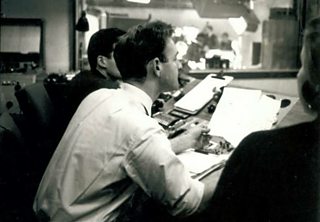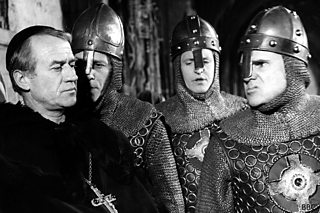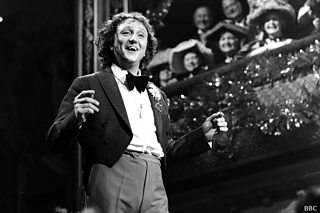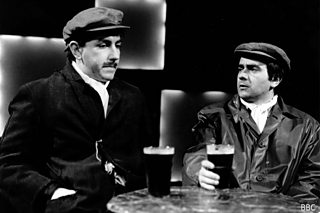Making trails for �������� TV - a director's story

Maurice Kanareck (in white shirt) directing in Pres A, one of the presentation studios at Television Centre, in the mid-60s
Maurice Kanareck began his television career in 1959. After working for ATV, he joined the �������� in 1963 to make trailers for the ��������’s Television Presentation unit.
I started at the �������� as a Director in 1963 in the last days of the ��������'s vision announcers. They included Judy Chalmers, Valerie Singleton and Val Pitts. Soon after I joined, however, they disappeared from our screens, but for the short time that they were with us, they were delightful to work with. At ATV, I had wanted to move away from the old routine of vision announcers and straight clips and slides, so I had devised elaborate mini-drama scenarios, sometimes using props, other times selected film clips – which were ideas I took to the ��������.
We had the whole run of �������� facilities. Our own studio was a three camera set-up, which we took full advantage of, but there was also the music library, stills library, pronunciation unit and film crews. How we actually made our trails was entirely up to us. There was no interference from above, and we had the luxury of being allowed to be creative and just “get on with it”.

A troublesome priest in trouble: Cyril Cusack in T.S. Eliot's play Murder in the Cathedral, in the series Festival - �������� TV, March 1964
Most of the trails were recorded in our studio, but we did often go out on location. In 1964, I made a trailer for the production of TS Eliot's Murder in the Cathedral, which was recorded as an Outside Broadcast from Canterbury Cathedral itself. Cyril Cusack played Becket and the trailer showed him walking through the crypt and being confronted by the three knights who were to murder him.
The scene ended with a 15-second "freeze frame" of the three knights drawing their swords and confronting him, under a superimposed title. This caused quite a lot of interest when I showed the trail at our re-run as, at that time, you couldn't yet freeze-frame 2" video-tape. The head of presentation, Rex Moorfoot, looked puzzled, and said "How did you do that?" So it was with great pleasure I was able to say "I simply asked the actors to stand still for fifteen seconds!"

The Squire of Knotty Ash makes one of his many appearances at the City Varieties, Leeds, for The Good Old Days
Another regular trail I enjoyed making was for The Good Old Days at the Leeds City Varieties theatre. Three things stand out. After a year, Rex Moorfoot forbade me to go up there to make any more trails. The reason was that he, not particularly liking the programme, thought that nobody else did either, and that I used it as an excuse to see some lady in Leeds! When he discovered that this wasn't so, I was then allowed to go back. Secondly, when Ken Dodd topped the bill for the hundredth programme, his two-hour routine had to be edited to the conventional ten minutes. And, thirdly, I went up to do a special trailer for a Good Old Days Christmas show. I met the stage door keeper, and asked him if there were any ghosts in the theatre. "Oh, ay..." he replied "...there's the grey lady..." "The Grey Lady?" I said. "Oh, ay" he replied "...of a night she appear on t'stage 'olding a burning candleabra aloft... and then she disappears from the feet 'uppards, and the last thing you see is the flame on 'er candleabra...". I don't know if he was sending me up, but it was a great story.

Peter Cook and Dudley Moore, who Not Only... improvised the script of their sketches, But Also... the trailer for the series
Then there was the trail for Peter Cook and Dudley Moore's Not Only But Also. They came up to our studio and asked me what I wanted them to do. Thoroughly intimidated, I said "I couldn't dream of telling you what to do..." and so they said that it was no problem, how long did I want, and asked for a copy of the Radio Times. Now, in those days, the back of the Radio Times was full of adverts for garden sheds and medical trusses, and so they ad-libbed for one full, hilarious minute on the virtues of those items.
One of the best trailers we did was the work of my friend, Bob Fisher, for a Play of the Week. Bob's trail was a single shot from inside a slowly moving car, tracking a man walking along the pavement. As the shot progressed, the man got closer and closer to camera as the voice-over explained what the play of the week was called. By then we could only see, in close-up, the man we had been following. The car, and the shot, stopped, and the man (who was the author) bent down until he was looking straight into camera and simply said "Watch it!".

Back at the coal face of Pres A.
We also did the occasional filler item, and I was once approached by Barney Colehan, who I knew well from The Good Old Days and was now producing It's A Knockout, to ask if I could do an on-air spot for him asking viewers to send in ideas for games for the next series. It was early days, and they were running short of ideas. So it was a great opportunity for me to do what I'm sure all directors want to do, and that's make a Western. At that time, the MGM Studios at Elstree had a permanent Western set, and so I got "Knockout" presenters David Vine and Eddie Waring to do a shoot-out in full cowboy rig, watched by a fearful saloon girl, singer Rita from the Good Old Days.
Ah happy days!
Non-�������� photographs provided courtesy of Maurice Kanareck